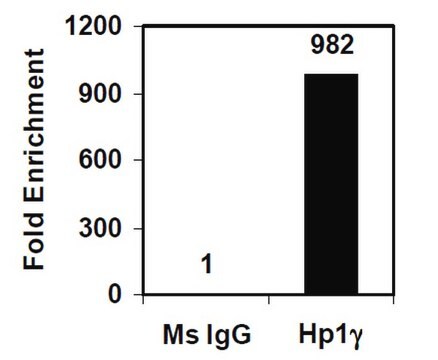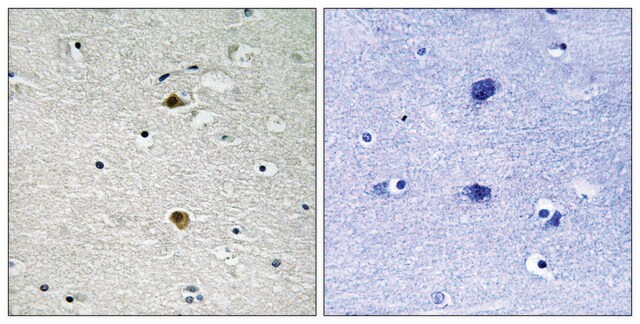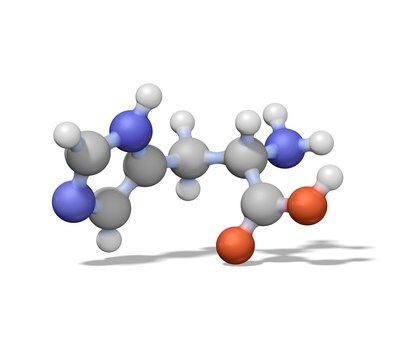17-10060
ChIPAb+ NFκB p65 (RelA) - ChIP Validated Antibody and Primer Set
from mouse
Sinónimos:
Chip Antibody and primer set, Nuclear factor NF-kappa-B p65 subunit ChIP, Transcription factor p65 ChIP, Transcription factor p65, Nuclear factor NF-kappa-B p65 subunit, Nuclear factor of kappa light polypeptide gene enhancer in B-cells 3
About This Item
Productos recomendados
origen biológico
mouse
Nivel de calidad
clon
monoclonal
reactividad de especies
rat, human
reactividad de especies (predicha por homología)
mouse
fabricante / nombre comercial
ChIPAb+
Upstate®
técnicas
ChIP: suitable
immunoprecipitation (IP): suitable
western blot: suitable
isotipo
IgG3
Nº de acceso NCBI
Nº de acceso UniProt
Condiciones de envío
dry ice
Descripción general
The ChIPAb+ NFκB p65 (RelA) set includes the NFκB p65 (RelA) antibody, a negative control normal mouse IgG, and qPCR primers which amplify a 299 bp region of human IκBα promoter. The NFκB p65 (RelA) and negative controls are supplied in a scalable "per ChIP" reaction size and can be used to functionally validate the precipitation of NFκB p65 (RelA)-associated chromatin.
Especificidad
Inmunógeno
Aplicación
Representative lot data.
Sonicated chromatin prepared from serum starved, TNFα-treated (20 ng/mL, 30 min) 293 cells (~3 X 10E6 cell equivalents per IP) were subjected to chromatin immunoprecipitation using 4 µg of Normal Mouse IgG or 4 µg of Anti-NFκB p65 (RelA) and the Magna ChIP A Kit (Cat. # 17-610).
Successful immunoprecipitation of NFκB p65 (RelA) associated DNA fragments was verified by qPCR using ChIP Primers, IĸBα promoter as a positive locus, and β-Actin promoter primers as a negative locus (Please see figures). Data is presented as percent input of each IP sample relative to input chromatin for each amplicon and ChIP sample as indicated.
Please refer to the EZ-Magna ChIP A (Cat. # 17-409) or EZ-ChIP (Cat. # 17-371) protocol for experimental details.
Western Blot Analysis:
Representative lot data.
Huvec lysate (Lane 1), L6 lysate (Lane 2) and PC12 lysate (Lane 3) were resolved by electrophoresis, transferred to PVDF membrane and probed with anti-NFκB p65 (RelA) (1:500 dilution).
Proteins were visualized using a goat anti-mouse secondary antibody conjugated to HRP and a chemiluminescence detection
system.
Arrows indicates protein NFκB p65 (RelA) (~65 kDa) (Please see figures).
A non-specific band may be seen at ~230 kDa in L6 lysate.
Immunofluorescence: A 1-10 μg/mL concentration of a previous lot was used in immunofluorescence.
Immunohistochemistry (paraffin sections): A 5-10 μg/mL (APAAP)
concentration of a previous lot was used in immunohistochemistry.
Immunohistochemistry (frozen sections): A 5-10 μg/mL (APAAP)
concentration of a previous lot was used in immunohistochemistry.
Electrophoretic Mobility Shift Assay (EMSA): A 0.5-1 μg/mL concentration of a previous lot was used in shift assay.
Flow Cytometry: A previous lot of this antibody was used in flow cytometry.
Optimal working dilutions must be determined by end user.
Epigenetics & Nuclear Function
Transcription Factors
Envase
Calidad
Sonicated chromatin prepared from serum starved, TNFα-treated (20 ng/mL, 30 min) 293 cells (~3 X 10E6 cell equivalents per IP) were subjected to chromatin immunoprecipitation using 4 µg of either Normal Mouse IgG or 4 µg of Anti-NFκB p65 (RelA) and the Magna ChIP® A Kit (Cat. # 17-610).
Successful immunoprecipitation of NFκB p65 (RelA) associated DNA fragments was verified by qPCR using ChIP Primers, IĸBα promoter (Please see figures).
Please refer to the EZ-Magna ChIP A (Cat. # 17-408) or EZ-ChIP (Cat. # 17-371) protocol for experimental details.
Descripción de destino
Forma física
Nornal Mouse IgG. One vial containing 125 µg of purified mouse IgG in 125 µL of storage buffer containing 0.1% sodium azide. Store at -20°C.
ChIP Primers, IĸBα promoter. One vial containing 75 μL of 5 μM of each primer specific for human IĸBα promoter. Store at -20°C.
FOR: GAC GAC CCC AAT TCA AAT CG
REV: TCA GGC TCG GGG AAT TTC C
Almacenamiento y estabilidad
Nota de análisis
Includes negative control normal mouse IgG and primers specific for human IĸBα promoter.
Información legal
Cláusula de descargo de responsabilidad
Código de clase de almacenamiento
10 - Combustible liquids
Certificados de análisis (COA)
Busque Certificados de análisis (COA) introduciendo el número de lote del producto. Los números de lote se encuentran en la etiqueta del producto después de las palabras «Lot» o «Batch»
¿Ya tiene este producto?
Encuentre la documentación para los productos que ha comprado recientemente en la Biblioteca de documentos.
Nuestro equipo de científicos tiene experiencia en todas las áreas de investigación: Ciencias de la vida, Ciencia de los materiales, Síntesis química, Cromatografía, Analítica y muchas otras.
Póngase en contacto con el Servicio técnico








